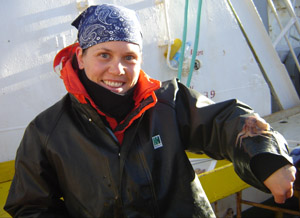 Fall 2006 |
|
| PREVIOUS | PAGE 1 | |
| This
is Not A Krill1: Scientific Trawling
in the Southern Ocean
Jennifer Van Dommelen |
 View
more pictures! |
I took the scenic route to get to last June's ABLE meeting at Purdue -- leaving Halifax in February, I made my way to Chile to join a National Oceanic and Atmospheric Administration (NOAA) research cruise to the South Shetland Islands and Antarctic Peninsula. After some leisure travel in Chile and 32 days at sea, it was on to San Diego for a few weeks of lab work at the Southwest Fisheries Science Center in La Jolla. Purdue was my last stop on the way home. With this article I'd like to share a little about "what I did last (austral) summer", and how I might relate this experience to my teaching. Other than to highly recommend Chile as a travel destination (and the Antarctic too of course, but, duh...), I'll keep the travelogue brief. Asking you to bear in mind that I'm not particularly well-traveled, had never been to a country where English is not widely spoken (y no hablo espanol!), and had never been at sea for longer than about 18 hours, I'll simply provide a list of subject lines from my travel dispatches, and let you fill in the blanks: As part of the United States' commitment to the Convention for the Conservation of Antarctic Marine Living Resources (CCAMLR), NOAA conducts annual surveys in the Southern Ocean to collect various biological and oceanographic data. An international treaty with 25 member nations, the Convention's goal is to manage Antarctic fisheries while at the same time preserving the stability of the Antarctic marine ecosystem. Sarah Shoffler describes NOAA's ecosystem approach to elucidating the relationships between zooplankton (notably krill) abundance and predator abundance, and the effects of commercial fisheries on local food webs. Research programs are primarily concerned with fish, zooplankton, pinnipeds, seabirds, and ecosystem modeling. I worked with Dr. Mike Goebel on the pinniped program, helping to quantify fur seal diet. Aboard the ship, my job was to pick through seal scats (not nearly as bad as it sounds) in search of fish otoliths and squid beaks, and to measure krill carapaces. At the lab in La Jolla, I isolated fatty acids from samples of fur seal prey, for later use in a technique called Fatty Acid Signature Analysis. (Seals incorporate prey fatty acids into their blubber and milk virtually unchanged; one can compare the fatty acids present in the milk and blubber with those of the prey and quantify diet more accurately than by studying scats alone.) The rest of the scientific crew worked on the fish program. At each sampling station, they would trawl the ocean floor, and sort and record whatever came aboard. By a few days into the cruise it became clear that the fish program was fast becoming a benthos program, as they caught a lot more benthics and a lot fewer fish than expected. Fortunately, I had the opportunity to help out with this work as well, and I joined the benthos crew whenever I could to help with the sorting. Life aboard the ship was certainly not all work, and we filled the downtime with iceberg-spotting, bird- and whale-watching, stargazing, "shore leave", games, movies, live music, and socializing with the Russian crew of our chartered vessel (the R/V Yuzhmorgeologiya ). As fieldwork goes, it was a pretty cushy gig. In supporting my application for a leave of absence, my Chair called the trip "a unique professional development opportunity". I hadn't thought of it that way at the time, but of course he was right, and I have since been reflecting on how I might translate my learning experience into one for my students. Give a special lecture? Devise some sort of case-study or literature search activity? Whatever it is, it's going to take some creativity on my part to come up with something that is engaging for the students, and not just an excuse to tell them embellished travel stories. (I was kind of hoping I would hit on something before writing this article, but it's a challenge I'm still working on.) In the meantime, I'm grateful for the chance to broaden my horizons as a biologist. I got to see and do some amazing things, and as far as professional development is concerned, the most important of these was some actual hands-on science. Having left research behind when I finished grad school, I had kind of forgotten what it could be like: the excitement (watching the net come aboard, wondering what was inside), the pitfalls (losing the net mid-trawl), the controversy (what if the captain refuses to take you to your sampling location?). The best part is that I got to participate in all the fun stuff without having to deal with the stress of being the PI. Now I realize that the chance to do science is as important a professional development opportunity as pedagogical workshops and the like, and I look forward to similar opportunities in the future.  View more pictures! View more pictures!1 T-shirt slogan for the 2006 cruise. Previous slogans include "Red Hot Krilli Peppers", "License to Krill", and "NOAA's Ark".
|
|
| PREVIOUS | PAGE 1 | |